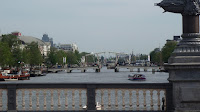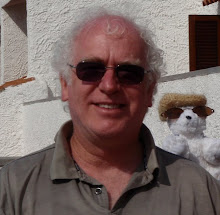



















At 20:30, when we boarded the candlelight tour boat at Ronkin Centruum, there were 4 tables arranged each with a candle, three bottles of wine, two types of cheese, and some salty crackers. By the time we departed the dock at 21:00 as scheduled, two more couple came aboard and two more tables were arranged simimilarly. It was a very pleasant evening and a nice way to see the night lights of Amsterdam along the canal. Unfortunately, by the end of the evening, my camera hadn't the capacity to capture the lights while we were moving...the result is rather intriguing though. I took some notes of the guide's annecdotes and was able to glean the following:
- the year 1275 is the earliest date on documents refer to Amsterdam
- Amstel, the river from which Amsterdfam gets its name, is the natural canal in the ...all other canals have been dug.
- hand operated wooden locks are used to refresh the canals with fresh water from a Lake in Switzerland via the river Rhine and the old water is flushed to the north sea
- there currently over 3000 house boats on the canals of Amsterdam...they all have electrical power and water...house boat living started because of a housing crisis in the 1950's
- st nicolas used to be patron saint of city...the cathedral remained catholic after the reformation.
- Kuiper (?) was the Dutch architect who designed both the central station and the Rijkmuseum
- the dutch warship Amsterdam was built in 1729 and sunk on its maiden voyage off the coast of England...it has recently been rebuilt by unemployed persons over a 5 year period
- there are 8 day cruises from amsterdam to Basel up the Rhine
- step, bell, and neck gable ...3 types of house fronts...some gables were purposely built with a forward inclination towards the sidewalk in order to facilitate hoisting furniture from street level.
- there are four tunnels connecting North Amsterdam with the centrum ad there is a free ferry service for pedestrians and cyclists transitig from the north.
- there is a floating Chinese restaurant which is a reduced replica of one in Homg Kong...the one in Amsterdam can seat 800 (the one in Hong Kong apparently will seat a few thousands.


































































